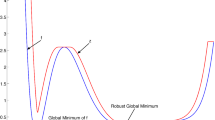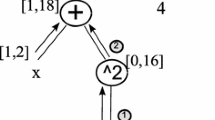Abstract
The aim of this paper is to find the global solutions of uncertain optimization problems having a quadratic objective function and quadratic inequality constraints. The bounded epistemic uncertainties in the constraint coefficients are represented using either universal or existential quantified parameters and interval parameter domains. This approach allows to model non-controlled uncertainties by using universally quantified parameters and controlled uncertainties by using existentially quantified ones. While existentially quantified parameters could be equivalently considered as additional variables, keeping them as parameters allows maintaining the quadratic problem structure, which is essential for the proposed algorithm. The branch and bound algorithm presented in the paper handles both universally and existentially quantified parameters in a homogeneous way, without branching on their domains, and uses some dedicated numerical constraint programming techniques for finding a robust, global solution. Several examples clarify the theoretical parts and the tests demonstrate the usefulness of the proposed method.



Similar content being viewed by others
Notes
The inconsistency seems to come from the fact that the new constraint after the change of variable involved in Appendix B of [30] contains several occurrences of universally quantified parameters, hence breaking the structure of the problem.
Also called splitting or branching.
Rigorously checking that an interval matrix is full rank can be done e.g. by using the interval Gauss elimination or by preconditioning the matrix using some approximation of generalized inverse of is midpoint.
Necessary for rigorously handling rounding errors.
constrained optimization problems usually have at least one active constraint at a minimizer.
Computed by averaging over the times divided by the number of pruning steps.
The cluster effect is a usual phenomenon when solving global optimization problems, see e.g., [14].
References
Adjiman, C.S., Androulakis, I.P., Maranas, C.D., Floudas, C.A.: A global optimization method \(\alpha \)BB for process design. Comput. Chem. Eng. 20, 419–424 (1996)
Alefeld, G., Herzberger, J.: Introduction to Interval Computations. Computer Science and Applied Mathematics (1974)
Ben-Tal, A., El Ghaoui, L., Nemirovski, A.: Robust Optimization, Princeton Series in Applied Mathematics. Princeton University Press, Princeton (2009)
Ben-Tal, A., Nemirovski, A.: Robust solutions of uncertain linear programs. Oper. Res. Lett. 25(1), 1–13 (1999)
Ben-Tal, A., Nemirovski, A.: Robust solutions of linear programming problems contaminated with uncertain data. Math. Program. 88(3), 411–424 (2000)
Ben-Tal, A., Nemirovski, A.: On tractable approximations of uncertain linear matrix inequalities affected by interval uncertainty. SIAM J. Optim. 12(3), 811–833 (2002)
Benhamou, F., Goualard, F., Granvilliers, L., Puget, J.F.: Revising hull and box consistency. In: International Conference on Logic Programming, pp. 230–244 (1999)
Blankenship, J.W., Falk, J.E.: Infinitely constrained optimization problems. J. Optim. Theory Appl. 19(2), 261–281 (1976)
Chabert, G., Jaulin, L.: Hull consistency under monotonicity. In: Principle and practices of constraint programming—CP2009, pp. 188–195 (2009)
Clarke, F.H.: Optimization and Nonsmooth Analysis. Society for Industrial and Applied Mathematics, Philadephia (1990)
Csendes, T., Ratz, D.: Subdivision direction selection in interval methods for global optimization. SIAM J. Numer. Anal. 34, 922–938 (1997)
Domes, F., Neumaier, A.: Quadratic constraint propagation. Constraints, pp. 404–429 (2010)
Domes, F., Neumaier, A.: Rigorous verification of feasibility. J. Global Optim. 61(2), 255–278 (2015)
Du, K., Kearfott, R.B.: The cluster problem in multivariate global optimization. J. Global Optim. 5, 253–265 (1994)
Ghaoui, L.E., Lebret, H.: Robust solutions to least-squares problems with uncertain data. SIAM J. Matrix Anal. Appl. 18(4), 1035–1064 (1997)
Ghaoui, L.E., Oustry, F., Lebret, H.: Robust solutions to uncertain semidefinite programs. SIAM J. Optim. 9(1), 33–52 (1998)
Goldberg, D.: What every computer scientist should know about floating-point arithmetic. Comput. Surv. 23(1), 5–48 (1991)
Goldsztejn, A., Domes, F., Chevalier, B.: First order rejection tests for multiple-objective optimization. J. Global Optim. 58(4), 653–672 (2013)
Goualard, F.: GAOL 3.1.1: Not Just Another Interval Arithmetic Library, 4.0 edn. Laboratoire d’Informatique de Nantes-Atlantique, Nantes (2006)
Hansen, E.: Global Optimization Using Interval Analysis, 2nd edn. Marcel Dekker, New York (1992)
Jaulin, L., Kieffer, M., Didrit, O., Walter, E.: Applied Interval Analysis with Examples in Parameter and State Estimation, Robust Control and Robotics. Springer, Berlin (2001)
Jeyakumar, V., Li, G.: Robust solutions of quadratic optimization over single quadratic constraint under interval uncertainty. J. Global Optim. 55(2), 209–226 (2013)
Kearfott, R., Nakao, M., Neumaier, A., Rump, S., Shary, S., van Hentenryck, P.: Standardized notation in interval analysis. In: Proceedings of XIII Baikal International School-seminar “Optimization methods and their applications” (Vol. 4, pp. 106–113). Irkutsk: Institute of Energy Systems, Baikal (2005)
Kearfott, R.B.: On proving existence of feasible points in equality constrained optimization problems. Math. Program. 83(1–3), 89–100 (1995)
Kearfott, R.B.: Interval Computations: Introduction, Uses, and Resources. Euromath Bull. 2(1), 95–112 (1996)
Kearfott, R.B.: Interval computations, rigour and non-rigour in deterministic continuous global optimization. Optim. Methods Softw. 26(2), 259–279 (2011)
Knueppel, O.: PROFIL/BIAS: a fast interval library. Computing 53(3–4), 277–287 (1994)
Lebbah, Y., Michel, C., Rueher, M.: A rigorous global filtering algorithm for quadratic constraints. Constraints 10, 47–65 (2005)
Lhomme, O.: Consistency techniques for numeric CSPS. IJCAI 1, 232–238 (1993)
Li, M., Gabriel, S., Shim, Y., Azarm, S.: Interval uncertainty-based robust optimization for convex and non-convex quadratic programs with applications in network infrastructure planning. Netw. Spat. Econ. 11, 159–191 (2011)
Mitsos, A.: Global optimization of semi-infinite programs via restriction of the right-hand side. Optimization 60(10–11), 1291–1308 (2011)
Mitsos, A., Tsoukalas, A.: Global optimization of generalized semi-infinite programs via restriction of the right hand side. J. Global Optim. 61(1), 1–17 (2015)
Moore, R.: Interval Analysis. Prentice-Hall, Upper Saddle River (1966)
Neumaier, A.: Interval Methods for Systems of Equations. Cambridge Univ. Press, Cambridge (1990)
Rump, S.: INTLAB—INTerval LABoratory. In: Csendes, T. (ed.) Developments in Reliable Computing, pp. 77–104. Kluwer Academic Publishers, Dordrecht (1999)
Schichl, H., Neumaier, A.: Exclusion regions for systems of equations. SIAM J. Numer. Anal. 42(1), 383–408 (2004)
Sherali, H., Adams, W.: A Reformulation–Linearization Technique for Solving Discrete and Continuous Nonconvex Problems. Kluwer Academic Publ., Dordrecht (1999)
Tsoukalas, A., Rustem, B.: A feasible point adaptation of the blankenship and falk algorithm for semi-infinite programming. Optim. Lett. 5(4), 705–716 (2011)
Wächter, A., Biegler, L.T.: On the implementation of an interior-point filter line-search algorithm for large-scale nonlinear programming. Math. Program. 106(1), 25–57 (2006)
Wolfram Research Inc.: Mathematica 7.0. Wolfram Research Inc., Champaign (2008)
Author information
Authors and Affiliations
Corresponding author
Rights and permissions
About this article
Cite this article
Domes, F., Goldsztejn, A. A branch and bound algorithm for quantified quadratic programming. J Glob Optim 68, 1–22 (2017). https://doi.org/10.1007/s10898-016-0462-0
Received:
Accepted:
Published:
Issue Date:
DOI: https://doi.org/10.1007/s10898-016-0462-0




